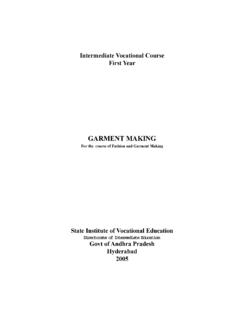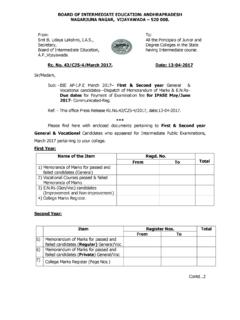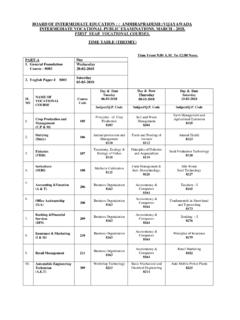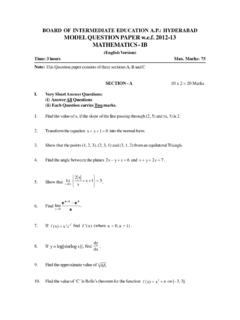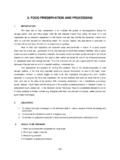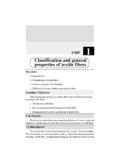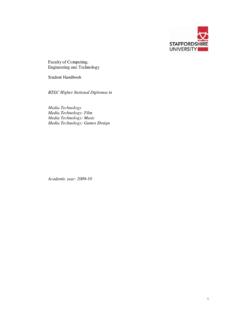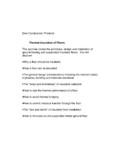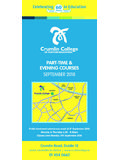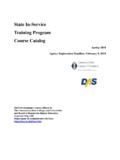Transcription of Introduction - Andhra Pradesh Board of …
1 Need for estimation and costingLearning ObjecyivesAfter studing this unit, student will be able to Have an idea of the Introduction to estimating and IntroductionIn the civil engineering field, the construction activity contains thefollowing three Plans : Preparation of drawings plan, section, elevation, with fulldimension and detailed, specifications meeting the requirements of the Estimation : Preparation of an estimate is for arriving the cost ofthe structure to verify the available funds or to procure the required funds forcompletion of the proposed Execution (construction) : It is a grounding the proposed structure,for construction as per the provision contained in drawings and Introduction1 UNIT Construction Technology152 The plans contains size of room and dimensions of the work and the estimatecontains the quantity and quality aspects of the DefinitionEstimation and costing there are two basic points involved inconstruction of structures are :1.
2 Quantity : The quantity aspects is with reference to the measurement in the drawings (plan, elevation, section)2. Quality : The quality aspects is with reference to the specifications, properties of materials, workmanship : The estimation and costing of any structure is defined as theprocess of determination of quantities of items of work, and its cost Estimate of a project is therefore, a forecast of its probable Need for Estimation and Costing The object of preparing the estimate for any civil engineering structure is1. To know the quantities of various items of work, a material and labour and their source of To decide whether the proposal can match the available funds to complete the To obtain the administrative and technical sanction of estimate from the competent authorities to release the funds for To invite tenders or quotations based on the estimate quantities for entrust of works to the Answer Type Questions1.
3 What is meant by Estimating and Costing ?2. State need for Estimation and Costing. Units of Rules For Different methods of tasking out quantitiesLearning ObjectivesAfter the studying this unit student will be able to To measure various quantities as per IntroductionThe units of differents works depends on their nature, size and general, the units of different items of works are based on the Massive or volumetric items of work such as earth work, conceretefor foundations, Masonry , Brick Masonry etc. The measurements oflength, breadth , height or depth shall be taken to compute the volume or Shallow, thin and surface work shall be taken in square unit or inarea. The measurements of length and breadth or height shall be taken tocompute the area, Ex. Plastering, white washing of Materialsand Works2 UNIT Construction Technology154 3. Long and Thin work shall be taken in linear or running units and linear measurement shall, be taken.
4 Ex : Fencing, Rainwater pipes, ornamental borders Single units of work are expressed in numbers. Ex. Doors, Windows, Rafters, Trusses Units of measurement for various items of CivilEngineering of items(a) Earth work excavation in alltypes of soils except rock re-quiring blastering.(b) Earth work excavation inthe soils hard rock requirngblastering.(c) Excavation of pipe linethrough of specified width anddepth inall types of soils(d) Earthwork for road for-mation ,bund formation , embankment.(e) Refilling of foundations ,basements, pipe lines, trencheswith excavated cement concrete or brick ma-sonry for foundation base-ment, super strucrture, parapetwall the basement withsand.(a) RCC 1:2: 4 with normalreinforcement for plinth beam ,columns, lintels, verandahbeam- T beam of Paper - II Estimating and (b) 1: 2: 4 for slabs ofspecified thickness .Plastering pointing, flooring,weather proof coarse, whitewashing, colour washing, with sheets, tiledroofing, Kurnool trerrace, Ma-dras terrace specified width and thick-nessWooden and steel trussesDoors, windows, border of speci-fied width and pipes, pipes GI pipes, stone ware reinforcement in stone pitching revet-ment and soiling of specifiedthickness.
5 (a) Roads works : Metal col-lections , gravel collections,solving stones, pitching anystones, revetment stones etc.(b) Road works : Spreadingmetal gravel and consolidationwith roller of specified thick-ness.(c) Cement concrete pay-ments of specified Construction Technology156 Rules For MeasurementMeasurement of works occupies a very important place in the planningand execution of any work or project, from the time of the first estimate aremade until the completion and settlement of payments. The methods followedfor the measurement are not uiform and the practices or prevalent differconsiderably in between the states. Even in the same state different departmentsfollow different methods. For convernience a uniform method should be followedthroughout the country. The uniform methods of measurement to be followedwhich is applicable to the preparation of the estimates and bill of quantitiesand to the side measurement of completed works have been described Rules1.
6 Measuremet shall be item wise for the finished items of work and the description of each items shall be held to inculde materials, transport, labour, fabrication, hoisting, tools and plants, over hands and other incidental charges for finishing the work to the required shape, size, design and In booking dimensions the order shall be in the sequence of length, breadth and height or depth or All works shallbe measured not subject to following tolerances unless otherwise stated.(a) Dimensions shall be measured to the nearest meter 1cm(1/ 211).(b) Areas shall eb measured to the nearest ( sqft).(c) Cubic contents shall be worked up to the nearest cum( )4. Same type of work under different condition and nature shall be measured separately under separate The bill of quantities shall fully describe the materials proportions and work-manships and accurately represent the work to be executed. Work which by its nature cannot be accurately taken off or which requires site measuremets shall be described as In case of structureal concrete, brick work or stone masonry, the work under the following categories shall be measured separately and the heights shall be described.
7 (a) From first floor level Paper - II Estimating and Costing157 (b) From plinth level to first floor level.(c) From first level to second floor level and so parapet shall be measured with the corresponding items of thestory next of units : The units of different works depend on their nature,size and shape. In general the units of different item of work are based on thefollowing principle.(i) Mass, voluminious and thick works shall be taken in cabic unit orvolumne. The measurement of length, breadth, and height or depth shall betaken to compute the volume cubic contents(cum).(ii) Shallow, thin and surface work shall be taken in separate units orin area. The measurement of length and breadth or height shall be taken tocompute the area ( ).(iii) Long and thin work shall be taken in linear or running unit andlinear measurement shall be taken(running meter).(iv) Piece work, job work etc taken in Different methods of taking out quantitiesThe items of work like earth work in excavation in foundation, foundationconcrete stone masonry in foundation and basement, stone or brick masonry insuper stucrture may by estimated bu either of the following Long wall and short wall method (or) General method2.
8 Centre line Long wall and short wall methodIn this method measure or find out the external lengths of walls runningin the direction generally the long walls out-to-out and the internal length ofwalls running in the transverse direction in-to-in of cross or short wall in-to-in and calculate quantities multiplying the length by the breadth and height ofwall. The same rule applicable to the excavation in foundation, to concrete infoundaiuon and to simple mehtod is to take the long walls of short or erros wallsseparately and to find out the centre to centre lengths of long wall anf shortwalls from the plan. For symmetrical footing on either sides, the centre lineremians same for suepr structure and for foundation and plinth. Construction Technology158 For long walls add to the center length one breadth of wall, whichgives the length of the wall out-to-out ,multiplying this length by the breadth andheight and get the quantities.
9 Thus for finding the quantities of earth work inexcavation, for the length of trench out-to-out add to the centre length onebreadth of foundaiton. Adopt the same process for foudation conceret and foreacth footing. It should be noted that each footing is to be taken separately andthe breadth of the particular footing is to be added to the centre wall length out-to-out = centre to centre length + half breadth onone side + half breadth on the other side = centre to centre length + one short or cross walls sub tract ( instead of adding) from the centrelength one breadth of wall, which gives the length in-to-in, and repeat the sameprocess as for the long walls, subtracting one breadth instead of wall length in-to-in= Centre to centre length - one is, in case of long wall add one breadth and in case of short wallsubstract one breadth from the centre length to get the corresponding will be noticed that by taking dimensions in this ways, the long wallsare gradually decreasing in length from foundation to superstructure, while theshort walls are increasing in method is simple and accurate and there is no chance of any method may be named as long wall and short wall method, or Centre line methodIn this method known as centre line method.
10 This method is easy andquick in calculations. In this method sum total length of centre lines of all walls,long and short has to be found out. This method is well suitable for walls ofsimilar cross sections. In this method the total centre line multiplied by breadthand depth of concerned item gives the total quantity of each item. In this method,the length will remain same for excavation in foundation for concrete in foundation,for all footings and for super structure (with slight difference where there arecross walls or number of junctions). It requires special attention and considerationat the junctions, meeting points of partition or cross walls, rectangular, circular polygonal (hexagonal, octagonal etc) buildinghaving no inter or cross walls, this method is quite simple. For each junction halfbreadth of the respective items or footings is to be deducted from the totalcentre length. Thus in the case of a building with one partition wall or cross wallhaving two junctions, for earthwork in foundation trench and foundation concretededuct one breadth of trench or concrete from the total centre length (half breadth Paper - II Estimating and Costing159 for one junction and the breadth ( 2 x 1/2 = one) for two junctions.)
